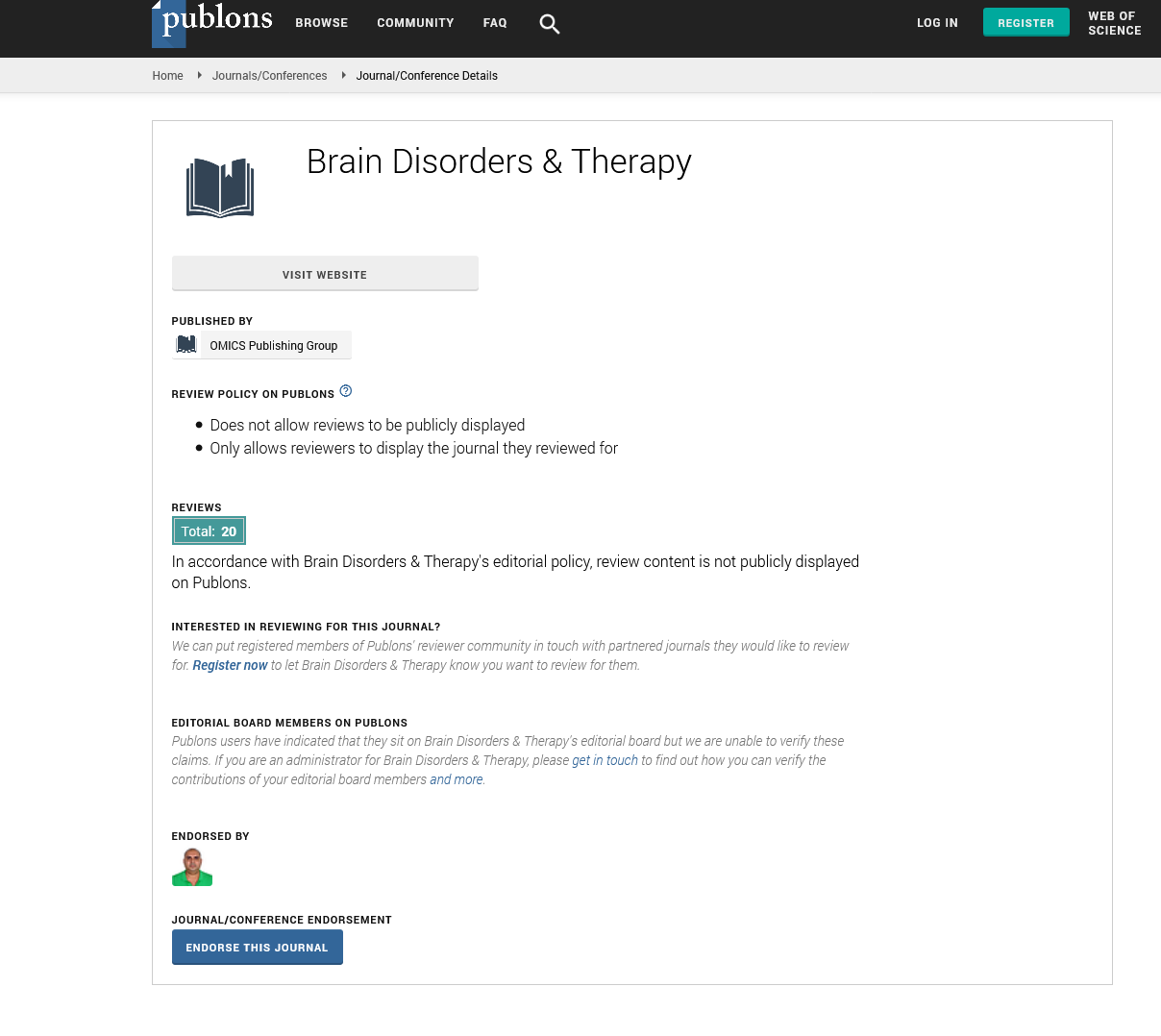Indexed In
- Open J Gate
- Genamics JournalSeek
- JournalTOCs
- RefSeek
- Hamdard University
- EBSCO A-Z
- OCLC- WorldCat
- Publons
- Geneva Foundation for Medical Education and Research
Useful Links
Share This Page
Journal Flyer

Open Access Journals
- Agri and Aquaculture
- Biochemistry
- Bioinformatics & Systems Biology
- Business & Management
- Chemistry
- Clinical Sciences
- Engineering
- Food & Nutrition
- General Science
- Genetics & Molecular Biology
- Immunology & Microbiology
- Medical Sciences
- Neuroscience & Psychology
- Nursing & Health Care
- Pharmaceutical Sciences
Commentary - (2025) Volume 14, Issue 2
Protein Based Evidence of Systemic Changes in Multiple Sclerosis
Masoud Nilsson*, Manuscript No. BDT-25-29719 ; , Pre QC No. BDT-25-29719 (PQ); , QC No. BDT-25-29719 ; , Manuscript No. BDT-25-29719 (R); , DOI: 10.35248/2168-975X.25.14.299
Description
Multiple Sclerosis (MS) is a chronic, immune-mediated disease of the central nervous system characterized by inflammation, demyelination and neurodegeneration. Traditionally, research has focused on lesions within the brain and spinal cord. However, increasing evidence highlights systemic changes in peripheral cells that may influence disease progression. Among these, platelets have emerged as an unexpected yet important player. Although platelets lack a nucleus, they are metabolically active and contribute to immunity, inflammation and vascular health. Their cytoskeleton, composed of actin filaments, microtubules and associated proteins, is central to shape maintenance, motility and activation. In MS, changes in both the quantity and organization of cytoskeletal proteins have been reported, raising questions about their functional and clinical relevance.
Platelet alterations in multiple sclerosis
Platelets in MS display multiple functional abnormalities that suggest an altered cytoskeletal framework. Studies report increased platelet activation markers, enhanced adhesion to endothelial cells and elevated release of cytokines and chemokines. Changes in granule content and surface receptor profiles further indicate that these cells are primed for exaggerated responses. Because platelet function depends heavily on cytoskeletal remodeling, these abnormalities strongly implicate cytoskeletal proteins as contributors to altered platelet behavior in MS.
Quantitative changes in cytoskeletal proteins
Proteomic studies using techniques such as two-dimensional electrophoresis and mass spectrometry have identified specific differences in cytoskeletal protein levels in platelets from MS patients compared to healthy controls. A reduction in actin levels has been reported, possibly linked to increased degradation or disturbed polymerization. Spectrin and filamin A, which anchor the cytoskeleton to the plasma membrane, also show altered expression, suggesting compromised structural integrity. Gelsolin, a severing and capping protein that regulates actin filament turnover, is often reduced, limiting the dynamic reorganization required for activation and motility. Similarly, impaired phosphorylation of cofilin, a key regulator of actin depolymerization, affects actin filament stability. Together, these quantitative changes may destabilize cytoskeletal networks, impair platelet homeostasis and promote abnormal interactions with immune and endothelial cells.
Structural reorganization of the platelet cytoskeleton
Beyond changes in protein quantity, structural remodeling of the cytoskeleton plays a decisive role in platelet function. Imaging studies, including electron microscopy and confocal analysis, reveal disorganized actin filaments that fail to form the characteristic peripheral ring, instead aggregating irregularly upon activation. Microtubule coils, which normally form a continuous marginal band that stabilizes platelet shape, appear shortened, fragmented, or broken. This destabilization impairs the ability of platelets to spread properly, as evidenced by defective filopodia and lamellipodia formation during adhesion. Additionally, clustering of granules, often linked with faulty cytoskeletal anchoring, has been documented. These abnormalities suggest that platelets in MS are predisposed to abnormal activation and exaggerated vascular interactions, which may contribute to neurovascular dysfunction observed in patients.
Relevance to disease pathology
The cytoskeletal abnormalities in platelets are not merely biochemical curiosities; they may actively contribute to MS pathology. Dysfunctional cytoskeletal remodeling can enhance platelet adhesion to vascular endothelium, promote the release of pro-inflammatory mediators and facilitate thrombo-inflammatory processes that exacerbate neurovascular damage. Abnormal platelet–immune cell interactions may further amplify peripheral immune activation, feeding into central nervous system inflammation. By destabilizing vascular integrity and fueling systemic inflammation, platelet cytoskeletal changes may represent a peripheral driver of disease progression, complementing central nervous system mechanisms.
Diagnostic and monitoring
Given their measurable and reproducible nature, cytoskeletal changes in platelets hold potential as clinical biomarkers. High-throughput proteomic and flow cytometry platforms can quantify these alterations and potentially link them to disease activity. Fluctuations in cytoskeletal protein expression may correlate with relapses, progression, or therapeutic responses, providing clinicians with valuable monitoring tools. Cytoskeletal protein signatures could also help differentiate MS from other neuroinflammatory disorders, aiding diagnosis. Although promising, these applications require validation in large, longitudinal studies before clinical translation is possible.
Platelets in multiple sclerosis undergo significant cytoskeletal alterations, encompassing both quantitative changes in protein expression and structural reorganization of filament networks. These modifications impair platelet function and likely contribute to the vascular and immune abnormalities characteristic of the disease. Understanding these changes provides new insight into the systemic dimension of MS and opens possibilities for biomarker development and adjunctive therapeutic strategies. As research advances, platelet cytoskeletal dynamics may prove to be a crucial link between peripheral cellular changes and central nervous system pathology in MS.
Citation: Nilsson M (2025). Protein Based Evidence of Systemic Changes in Multiple Sclerosis. Brain Disord Ther. 14:299.
Copyright: © 2025 Nilsson M. This is an open-access article distributed under the terms of the Creative Commons Attribution License, which permits unrestricted use, distribution, and reproduction in any medium, provided the original author and source are credited.


